
Note: Tools that have disappeared from the Woodbutcher’s inventory can be seen in theWoodbutcher’s Graveyard.
Well, if the list of tools wasn’t enough of an ostentatious display of accumulated treasures, here are pictures of many of my tools with some comments. As usual, the pictures are shown here as thumbnails to speed up loading of the page. Just click on the picture to get a larger view, and each picture opens into a separate browser screen (the same one).
Most of these pictures are of my actual tools, but some are pictures of tools much like mine that friends sent me because mine were temporarily unavailable, and some are pictures from either manufacturers’ or distributors’ sites.
Update: 12 January 2014. Time for some loose end tying. This page contains content that may be as much as twenty years old. Much of it was written contemporaneosly with the acquisition of a tool and may include descriptors such as “recently”. In my sloppy manner, I never went back and introduced a more chronologically apt scheme of describing my kit, and it now looks like I’ve bought a bunch of tools, well, recently. I’m going to try and clean that up. In truth, while I have a generally good idea of when, where, and under what circumstances I bought something, going back twenty years or more is murky territory for anyone. And in some cases (Black & Decker grinder), I simply have no idea when (or where) I got it.
More: November 2014. I added a couple of composite pictures of measuring and gauging accessories and reorganized a little bit in that department, adding a category. As I re-read all I’ve crafted over the years, I see I’ve created an impression that I started woodworking around 1995. In truth, by 1995, I’d been woodworking for nearly forty years at some level or another. I’d worked with my father on several DIY projects throughout the ’60s until I moved away. And I can recall early experiments in the ’50s with tools, some far more powerful than my need or capacity warranted.
I was buying socket wrenches in the ’60s, got my first saw (Skil, circular) probably in 1969, and probably acquired my first drill at the end of that decade shortly thereafter. I know I had the saw on a portable stand in 1970 and hacked together an ugly nightstand on the patio of the apartment we lived in at the time. From the time we bought our first house in 1972, I’ve had a shop presence in every place we’ve lived and have acquired tools in every decade—SWMBO would argue “every year”—since. It’s just that many of the early tools have been retired or replaced by more recent acquisitions, thus giving the impression I’ve only been at this since the ’90s.
By the way, although I am not obsessed with Norm Abram, I have gotten a lot of inspiration from him and I have wound up buying a number of tools that he also has—not because he has one, but because it’s a good tool. In a couple of cases I probably had the tool before he did. Each instance will have this graphic, The New Yankee Workshop logo, associated with it: 
Saws |

Delta Unisaw 
|
After years of making do with a Sears table saw (from roughly 1988), I finally pulled the trigger on a Unisaw (’04). It was quite a debate between it, a Powermatic 66, and a General 650. In the end, money talked, because Woodworkers Supply had this for $1500 with the mobile base and free shipping. I now have the same five major tools that Norm has (Unisaw, 28-280 bandsaw, DC380 planer, DJ20 jointer, 17-925 drill press—actually, six, if you count the 46-701 lathe he's used a lot, although that's never been his primary lathe). Maybe I am obsessed. Actually, it just happened that way, as you will read below. |

Bosch 1584 Jigsaw 
|
This is the Bosch 1584 jigsaw with the barrel grip. I much prefer it to the top-handle model (1587). In fact I ordered a 1587 for my first good hand power tool (around 1995), and in the midst of my first cut, my hand automatically slipped down to the barrel, and I said, “ah, ha!” I sold it to a friend at work and ordered the 1584 the next day. |

P-C SawBoss 
|
When I needed to use a circular saw to build a packing crate for a glass table top, and my Skil was already in storage, I hit the phones and found a Porter-Cable Sawboss at a really good price (≈1998). Just like all the rest of the P-C tools I have, it comes to play. No nonsense, just solid dependable performance. You could probably frame with it; the 6" capacity is somewhat limiting for that purpose, but the ads say it'll cut a 2× at 45°. The one downside is that the 6" blades aren’t as readily available as 7¼", so lay in a supply. |

P-C 314 Trim Saw 
|
I saw the value in a small light circular saw watching, who else, Norm cutting sheet stock. When the opportunity presented itself to justify buying Porter-Cable’s Trim Saw, I took advantage (≈1996). The only thing I don’t like is the angle the trigger lies at in the grip. It’s a little crowded in there. And the thing really spits the dust. Definitely a safety glasses tool, as if they all weren’t. |
|
Delta 28-280 Bandsaw 
|
The Delta 14" band saw was my second big Delta power tool purchase (see the DJ-15 in theWoodbutcher’s Graveyard). After lugging the DJ-15 down the basement stairs, I wasn't surprised at the weight of the bandsaw, but I was surprised that it was impossible for me to get it up on the base by myself. With the kids away at school I had to have my buddy (SWMBO) help me. She was not thrilled. |
|
P-C Reciprocating Saw |
One time, for no real reason, I felt I needed a reciprocating saw. My son bought me a Makita (≈1995—see story onWoodbutcher’s Graveyardpage), which was great. But when a local hardware store had a P-C which has a quick change chuck on clearance for a ridiculous price, I whipped out the Visa on the spot (≈1997). The Tiger Saw lives up to that billing. First with the quick change chuck, it’s still the most powerful recip saw on the market. I’ve used it a lot in the house remodel I’m doing. |
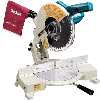
Makita LS1030 Miter Saw 
|
I got a really good deal on my Makita LS1030 miter saw at a local lumberyard (1992). I’ve never been there, before or since, but for some reason they had an exceptional price, so I got it. I find I use it a lot for cutoffs when the table saw is otherwise engaged or when I need more precision or capacity than the bandsaw. |

Craftsman Radial Arm Saw |
I finally got around to getting my RAS cleaned up, in front of your basic ebay background, and photographed. Distinguishing features of this model are: the arm lock at the end of the arm, the ON/OFF switch on the motor housing above and to the left of the handle, the elevation crank under the table, and the splitter which houses a light. The cabinet base (with five drawers in it) is devoted to radial arm saw things. I bought this new in 1972. |
Planers and Jointers Not planners and joiners |

Delta DC380 15" Planer 
|
I have always wanted one of these, and when a nearby woodworker offered this (and the DJ-20—2004) at a very attractive price, I couldn’t resist. Four of us almost killed ourselves getting it out of the trailer and onto the stand. I’m so glad I bought a mobile base for it before unloading it. I sold my Delta lunchbox planer (22-540—seeWoodbutcher’s Graveyard) a short time later. |

Craftsman Planer |
This tool, a power plane, I inherited from my father (1995), and I probably wouldn’t have bought one myself. I’ve only used it once, and frankly, I wound up doing the job with a hand plane better. Maybe I’ll do a door with it sometime. |

Delta DJ20 8" jointer 
|
Well, I never thought I’d have one of these! However, fate intervened, and a fellow woodworker from only 40 miles away placed an ad for this and the DC-380 at a price too good to pass up, and the next thing I knew (2004), the shop was cluttered with jointers and planers. Even heavier than the DJ-15 (what a surprise), but not as bad as the DC-380 planer. |
Drill Press and Drills |
|
Delta 17-925 Drill Press 
|
Well, I was planning on replacing the Sears drill press I had (see theWoodbutcher’s Graveyard) with a Delta 17-965, but an opportunity arose to get a 17-925 at considerable savings plus a $100 rebate, and I couldn’t pass it up (2003). It’s continuously variable speed set by the dial on the front of the hood. If there’s a more convenient speed control, I don’t know what it is. The only thing it lacked was a built in light, but unlike many drill presses in the 17-965 class (the one I didn’t get) it has a quill lock. Very handy—the Sears had it, too. |

Milwaukee Close Quarters Drill |
This is the Milwaukee Close Quarters Drill (≈2000). It looks odd, but it is unbelievably handy for drilling in, well, close quarters. It actually does a great job in any situation, as you have the feeling of being able to get more heft behind the bit. If it wasn’t for my cordless drills, this would get the most use in my shop. |

Makita Hammer Drill |
I wanted a hammer drill for the longest time but could never quite justify one. Finally, I found myself in a position where I had to have one (breaking up some concrete preparing for the move South in 1998), and I found a really good deal on the Makita HP-1500 through the Internet. It’s been very effective every time I’ve used it. |

Milwaukee Drywall Screw Driver |
My second Milwaukee drill (but third Milwaukee tool—see Angle Grinder below, then Close Quarters drill above). I actually got some use out of this drywall shooter when I was doing fix up on our Illinois home prior to putting it on the market (1998). Now with a house remodel in progress, I’ve used it a lot. |

Milwaukee Spade Drill |
I had sort of been looking for a D-handle ½" drill, commonly called a spade drill, both for mixing drywall mud and mortar, and for drilling plumbing/electrical holes in framing (≈2003). This Milwaukee brute fills the bill nicely. Not quite as good for holes in stud bays (better for electrical than plumbing) as the Hole Hawg (but $100 less), but I wouldn’t mix mud with a Hole Hawg, anyway. This baby is not for the faint of heart. There’s no trigger lock—what does that tell you? |
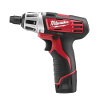
Milwaukee Driver |
Yet another Milwaukee tool. I read a report on the wreck of a lithium-ion power driver being offered at the borg for a ridiculous price. I went to check it out and found this (≈2006). It has transformed my cordless driver habits. It is so good I bought one each for my son and son-in-law for Christmas…in August! |
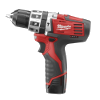
Milwaukee 3⁄8" Hammer Drill |
I was so enamored with the M-12 series of tools, that when it became time to replace the original batteries (they don’t last forever) I figured the most economical way to do that was to get the companion 3⁄8" drill as well. The whole point was to get a variable chuck capability to complement the hex drive of the driver above. After a short discussion, I let the owner of my local tool store convince me of the wisdom of ordering this hammer version of the drill I had in mind (2010). |

Milwaukee Impact Driver |
Well, this is just sad. One would think I have enough drill-like tools. But my local plumbing supply had this imact driver on sale at Christmas for just $100 (2011). For another $50, I got two additional batteries. Along with the two that come with the impact driver, that means the tool, plus four batteries, for a buck and a half. And, I now have the full suite of M-12 driver tools. Sweet. By the way, it isn’t for changing tires—it’s the latest thing for driving screws—lots of them—and quickly. Demolition turns out to be handy, too. |

Skil ½" Drill |
I’ve had a Skil drill of one kind or another since probably 1966. After I found myself using cordless drills almost exclusively, I gave my old 3⁄8" drill to my mother. I don’t remember when I got this ½" drill, but it was probably in the ’70s. I still have it, as there are times when one needs the extra oomph a corded drill provides. And occasionally the ½" capacity comes in handy. Of course I do have the hammer drill, and now the Milwaukee spade drill… |

Makita 6510 3⁄8" Drill |
As described above, I’ve been 3⁄8" drill poor for a number of years. I have so many other drills, it generally doesn’t matter, but every once in a while, you need the torque of a corded drill plus the higher RPMs of a 3⁄8" drill. I found this in a resale shop for $15 (2011). It has a little bit of tool box rash, but works great. Had to buy a chuck key, though. Also had to convince SWMBO that I needed this to go with my nine other drills… |
| Is anyone counting? Isn’t this like twelve drills? The router count down below is almost as bad. Can someone call a doctor? The doctor has responded. I’m now down to nine. The three Makita cordlesses have been consigned to the dustbin of history. Still a lot of drills… | |
Lathes |

Jet Mini Lathe |
My second (or third) lathe (seeWoodbutcher’s Graveyard). I got a good deal on this Jet Mini lathe (used—≈2000) at a local Woodcraft. When I was space impaired in a condominium, I thought I might be able to take this out on the lawn every once in a while, and although I did that a little, and also did some turning inside, neither was a satisfactory experience. Having a shop again in the new house should bring back the enjoyment. |
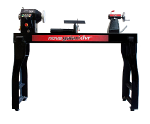
Nova Galaxi 1644 |
Another Woodcraft special (July 2018). It was a floor model with a small discount but it happened to address most of shortcomings I’d encountered with my Delta 46-701 (Woodbutcher’s Graveyard), most particularly variable speed (but not the Reeves drive of the Delta). This sixth one is a beast and is my lathe for life. If you’re wondering, it weighs 450 lbs! Just happened to realize, all of my lathes beyond the original Sears I bought (also historyWoodbutcher’s Graveyard) have been purchased at Woodcraft, at a discount. Three different Woodcrafts, too. |
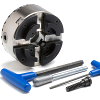
Vicmarc VM120 Chuck |
Wanting to do some small bowl turning, I’ve been lusting for a chuck since the first time I saw a Nova out at The Hardwood Connection in their old DeKalb location. After some research and pricing I got a Vicmarc VM100 (≈2001) and it’s a very impressive chuck. With the new Nova, whose spindle is larger than the Jet (1¼" vs 1"), I was faced with buying a new insert or buying a new chuck and insert. I ordered the insert but found I was unable to remove the old one. So, I got back on the phone, coordinated to return the insert in transit, and ordered a VM120 (plus insert ). They essentially look the same. Nothing wrong with the 100, but the 120 is about 25% larger and more suits the larger capacity of the Galaxi. Plus, I won’t have to swap out inserts on the 100 if I want to turn something on the Jet. Oh, the 100 is now in Illinois with the Delta lathe (seeWoodbutcher’s Graveyard). |
Routers |
Sanders |
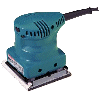
Makita ¼ Sheet Sander 
|
I can’t remember when I first bought my Makita BO4510 ¼ sheet sander (≈1994), but it was one of the very first of my next level power tool purchases. It does a nice job, although this is an early model without dust collection. Since I got the P-C 333 ROS, I don’t use this much. |

P-C 333 Random Orbit Sander 
|
I got such a good deal on the Porter-Cable 333 5" random orbit sander that I bought two more for the kids for Christmas (≈1998). I know some people complain about the little dust catcher, but mine stays on pretty well. Most of the time I have the Porter-Cable hose attachment on it, which really sucks. Ha, ha. |

P-C 343 Random Orbit Sander |
I’m a little confused at this late date. I seem to remember I bought this as a replacement for a surplus 333 I had at one time, but I just can’t recall. I apparently felt I was ROS poor at one point so picked this up which was P-C’s replacement for the 333. I’ve had sanding disc inventory issues as this has an 8 hole base while the 333 has a 5 hole. Problem solved when the base on the 333 rotted out or something and the replacement pad had a universal 5/8 hole pattern. |
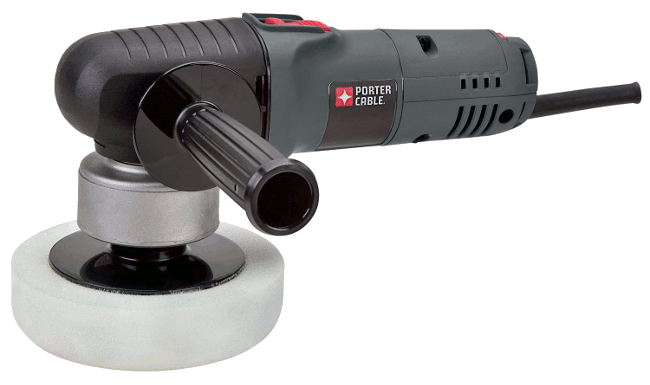
P-C 7424xp Variable Speed Polisher |
While not intended for woodworking, this is still a power tool and since it’s based on Porter-Cable’s 733X series sanders, certainly deserves a spot on this list. I bought it for assistance in keeping my new (old) Boxster looking good. |
Miscellaneous Power Tools |

Craftsman Bench Grinder |
I’ve had this Sears bench grinder for years. I bought it at the same warehouse where I got the belt sander. It does an okay job. How special does a grinder have to be? Although you can’t see any of it, it’s mounted on a stand I built out of Southern yellow pine in about 1972. |

Delta Bench Grinder |
The local Ace had this on offer for a ridiculous price with an even more ridiculous rebate (Christmas time, 2009). I wound up getting it for about $20. I’ve put better wheels on it and I think I’ll relegate it to lathe tool sharpening duty. |

Black & Decker Grinder |
Ordinarily one wouldn’t be able to find much Black & Decker stuff in my shop. But apparently I was desperate enough for a grinder and the price must have been such that one followed me home. In truth, it’s much more substantial than modern B&D products, so I actually don’t mind having it. But, I’m not sure when or even where I got it. After the Harbor Freight (now gone—seeWoodbutcher’s Graveyard), maybe even after the Delta. |

Milwaukee 4½" Angle Grinder |
I bought my first Milwaukee—this angle grinder—at a family sale at Home Depot when my son was working there (≈1994). I bought it mainly because it was a Milwaukee. They have a top rate reputation for their tools. I’ve come across some uses for it that I couldn’t have done easily with any other tool. Looks like I made a good decision. |

MK-Diamond MK370 Tile Saw |
This is the M-K Diamond MK370 tile saw. I had rented an MK101 once, its big brother, which is a real brute. It’s also about $800, so I never would have bought one. However, I found this one at a Woodworker’s Warehouse (1999—now gone) at a reasonable price and it’s been incredibly useful for the massive bathroom remodel I did as well as other tile jobs, most recently (2017), the floor of our new Florida room. |

Elu 3379 Biscuit Joiner 
|
When I went shopping for a biscuit joiner, I went to the same store where I tried out plunge routers. There was a salesman there that really knew the products, and he sold me the Elu 3379 (≈1996). I haven’t been sorry. It eventually turned into the DeWalt 682 (which Norm has used) when Black & Decker bought Elu; and is sort of like the Porter-Cable. In fact it looks a lot like the P-C 557, which obviously borrowed heavily from it in design. |
|
Dremel Moto Tool |
After wanting a Dremel Moto Tool since I was about ten years old, I finally got one several years ago (several years, indeed—I have no idea). Although not what you would call a workshop necessity there are lots of projects that I couldn’t have accomplished without it, or at least without a lot of grief and jury rigging. I’d say it’s earned its keep. |

Foredom Tool |
I have seen the Foredom flexible shaft tool advertised for many years, and thought it might be handy around the shop. However, I had it so far down the Tool Buy list that if I hadn’t inherited the one my father bought, I probably wouldn’t have it yet (1995). This was the one good tool that he ever bought, and I’m sorry he didn’t take the opportunity to buy several more. Not for me, but he loved working with good tools, and he ought to have been able to. |
Work Stations |

Lervad #610 Bench |
Okay, there were two good tools he had (1995). He bought this Lervad bench for his carving. I sort of scoffed at it, always imagining an 8’ European cabinetmakers bench as the only proper bench, but when I was in the condo, it didn’t seem like such a bad idea. It’s certainly sturdy and nicely designed. Remove three bolts and the top comes off, loosen four wooden nuts on the two ends and the legs fold up against the cross brace with hinged through-bolts—stores in a pretty small space. I have it set up permanently and it doubles as an outfeed table extension for the table saw. |

Workmate |
A Black & Decker Workmate is worth its weight in gold (and one of the few Black & Decker tools I’d own). It’s incredibly handy and very strong. This is my best tool bargain, because I got it for free and no one had to die. A friend gave it to me about 1985, in exchange for some tower work and general friendship. I think of him every time I use it. If you have Scott Landis’ The Workbench Book read the story behind the Workmate and its development. This one is a 79-001—an early model, but after they’d changed the cross braces from elegant castings to stamped metal. Those were really pretty. |

Work Station |
I think I mentioned in my Shop Tour page that I saw this work station on display at Home Depot once, and bought one on the spot (≈1997). This has to be the best portable chop saw (or other tool—I use my Omnijig on it, too) station on the market. Mine is the TracMaster® and was made by TracRac. This image is from the literature which accompanied it, and that Hitachi on it isn’t mine. I think they might still supply the extrusions, but the unit’s provenance is quite murky, several generations removed from my acquisition. I’m not sure it’s even available any more. |
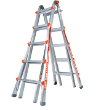
Little Giant Ladder |
You may have seen these hawked on TV with Robin Hartl (Hometime) and Richard Karn (Home Improvement). I saw a demo at a local home show. Yes, it seems gimmicky. Yes, it’s an info-mercial. Yes, it’s heavy. Yes, it’s pricey. Trust me. You wouldn’t be making a mistake buying one. This is my go to ladder for almost everything. Mine’s a five rung model—not quite so colorful—but they come in all different sizes. Among the first heroic jobs this did was serve as a support for a platform on stairs so I could paint the walls in the two story stairwell. Beautiful. |
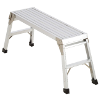
Work Platform |
Well, if a ladder as a work platform, why not a real work platform. This is Werner’s AP-20. I picked it up at the big box, probably around 2003 as I was working on our house remodel. It’s incredibly useful, as it’s a bit taller than my Rubbermaid step stools (I suppose I’m going to have to chronicle them, too) and provides a whole lot more maneuvering room. I was surprised at how relatively inexpensive it was, although in ten years it’s gone up a bit. |

Rubbermaid Step Stool |
As advertised, here is my Rubbermaid step stool (I actually have a couple of them). Folding handle in the top, very convenient to move around, provides a solid, stable platform about a foot above the ground. The top opens up to a space to toss a small collection of tools. There’s even a tool tray inside, too. It makes for a handy go-kit for household tasks or to take along to help the local widder lady. |
Clamps |

Bessey K-Body Clamps 
|
Bessey K-Body clamps are easily the best inspiration I’ve gotten from New Yankee Workshop (first ones ≈1994—in pairs for several years thereafter). If you haven’t used any yet, you are in for a treat. They behave like real tools ought to. They clamp evenly and firmly, and although I thought the handles wouldn’t provide enough purchase to clamp things tightly enough, that proved to be wrong. I’ve also learned a lot more about gluing up panels, so I don’t have the need for zillions of pounds of clamping force anymore. Warning! They are heavy. Wherever you store them, be sure it’s sturdy. When you get ready to move them somewhere else, be prepared to carry little more than 4 or 6 at a time. I have 2 12", 22 24", 8 40", and 2 50". Clickhereto learn how to choose your first K-bodies. |
|
Bessey Tradesman Clamps 
|
I am a late convert to Bessey’s Tradesman clamps (≈2000) and am very impressed by them. I’ve steadily increased the inventory (one must always buy clamps in pairs; it upsets the balance of universe to ignore this principle), as they’re much cheaper than the K-Bodies. The small ones (4 or 6"ers) are really handy for clamping stop blocks on the fences of saws and other tools or for clamping tools to benches or Workmates. |
|
Quick-Grip Clamps 
|
When Quick-Grips first came out I thought they were a great idea. I snapped up a couple of combo sets, ending up with four 12" and four 6" (≈1995). I’ve since added a few of the mini size, too. Experience has shown that they aren’t suitable for anything that has to stay in position or needs a lot of clamping force. I don’t trust them for critical stops or guides, but there are times when they are just the thing. |

Handscrews 
|
I sure wish I knew why these clamps were called handscrews. I have a couple of pairs (and I think they’re even Jorgies, like these). I think one pair is a #1 and the other pair is a #0 (or aught as they say in the UK). Surprisingly useful (mid-’90s). |

Bessey Band Clamp 
|
I was so impressed with my Bessey K-Body clamps, and so disappointed with every band clamp I’ve ever seen (with the exception of the Merle), that I jumped all over this when I saw it in a store (mid-’90s). It performs just like a band clamp ought to, except if you’ve never used one, don’t expect the same sort of clamping pressures you can get with a K-Body, pipe clamp, or hand screw. |
Measuring and Layout |
|
Starrett Combination Square 
|
If you’ve never used anything but a hardware store combination square, you can’t imagine how nice a Starrett square is. It has transformed my opinion of these tools. McFeeley’s was offering these at a nice price (compared to the usual) around 2006 and I treated myself to one. I was amazed at the difference. The rule is etched, not stamped. It’s unbelievable how readable it is. Norm has one, although it’s not featured like other tools are. |

Squares |
You may infer that I have other combo squares (chicken/egg), and you’d be correct. I have a decent one with an 18" bar, which comes in handy occasionally. I also have a Starret with a smaller head and a 6" bar. In addition, I have framing squares (for big work) and a couple of engineer’s squares, which do duty around the saws and jointer. I won’t mention the drywall square nor the drafting T-square (which I might not even have anymore). Also in inventory is a Speed Square and a combo push stick which has a square function—last resort, probably. Please note that the squares in the image are not to scale. The framing square is much bigger than the engineer’s square. Similarly, the Speed Square is smaller than the push stick. And that drywall square has an arm that’s 48" long. |

Tapes & Rulers |
Although there is a scale on many of the squares, it’s often inconvenient to do any significant measuring with them, particularly over a distance greater than a foot or so. Naturally, then, I have several retractable tape measures (English, metric, at varying lengths), one of which is a “centering tape” which allows one to find the center of an object without having to do fractions. I also have a vintage carpenter’s folding rule, at least two 100' rules, not to mention my measuring wheel which goes to 10,000' or ∞, depending on your memory. |
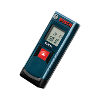
|
Deserving a specialty paragraph, this year’s (2015) Christmas present is this Bosch laser measurer, the GLM-15. It has a 50' capacity, is particularly adept at measuring inside dimensions, works in either English or metric values, has a hold function, and stores two measurements. For $40 (well, it was, then went up almost $20, now the model is discontinued), it was a steal. As you can see in the larger image, it’s quite compact—a true pocket tool.
Well, there’s always a story. I lost it. I couldn’t figure out how, and I searched high and low several times. I had a real need for it, too, but the last I remember, I had set it on the top of the table saw. Sadly, that space is cluttered with the remains of the last two or three small projects I’d undertaken, but even with several repositions of the detritus, the measurer was nowhere to be found. Finally, I gave up in disgust and ordered a new one (upgrade to GLM-20), understanding full well that as soon as it arrived, the -15 would turn up. Sure enough, two days after unpacking the -20, I moved some stuff away from the saw, and there on the floor was the -15. So, basically I now have two. No additional picture, as they are virtually identical in outward appearance. |
 Warner No.3 Straightedge
Warner No.3 Straightedge |
Following are a couple of layout/measuring fixtures that have proven invaluable over the years. This first, a Warner No. 3 wallpaper straightedge, is one of the tools I’ve had the longest. I have no idea where I got it (and I’m pretty sure I found it) or when, but it probably dates to the mid-'70s when I actually learned to wallpaper. Because it’s 7' long, it’s served workshop duty, as well, acting as a guide for cutting sheet goods. The image is principally of the cross section, measuring 2¾" wide by ½" thick…just picture it 7' long. I don’t understand why I’ve never been able to find an image of this on the 'net. It’s not like I’m unaccomplished in searches… |
 Empire Pro’s Edge 900 Cutting Guide |
Of course the operative phrase of the above is “7' long”, which disqualifies it for the odd occasion of having to rip an 8' sheet. So, I purchased this two piece (each ≈55"long) straight edge I found somewhere, some time—again, no idea of either, although most likely in the ’90s. Originally it had a piece of steel bent into a wide “U” which acted as a spring splint between the two halves. I found that inadequate and recently machined a heavy block of aluminum to fit and then drilled and tapped for eight countersunk Torx screws (in a metric thread) for those times when I need all 8+' of guiding capacity. Left image is the two pieces together with the clamps and screwdriver, middle image is the aluminum joiner, right image is the profile of the extrusions. |

Tru-Grip Clamp-N-Guide 
|
When I first saw the Tru-Grips, both the Clamp-N-Guide and the Back-to-backs, I knew I needed some (mid-’90s). Although for a long time I didn’t have the workbench to properly exercise the Back-to-backs, I have used the Clamp-N-Guides quite a bit. Very useful tools. Oddly enough, this is a picture of the bottom of the clamp. The top is just a boring flat piece of aluminum extrusion. I guess tha’s why they took a picture of the bottom. The longest one I have is about 48" so they’re nowhere near long enough for the length of sheet goods, thus the two piece guide above. |

Tru-Grip Back-to-Back 
|
Back-to-back |
Dust Collection |

Craftsman Shop Vac |
I’ve had this shop vac for years. I must have bought it about 1972. One of my earliest tools. It earned its keep once when we spilled almost a full gallon of latex paint onto a deep pile textured carpet. We sopped up as much as we could, then started pouring water on it and sucked the water up with the vac. I’ve replaced the bearings in it once. You can’t do that on modern shop vacs. |

Ridgid Shop Vac |
Early on in the condo experience (and with the Craftsman in storage) I had a need for more vacuuming power than the little carry-around or the upright could handle (≈1999). I wandered over to the borg and after some back and forth (the only one they had was a free-rental-army return) I got it for $30. It’s a cute little thing and was perfect for the condo. It’s now doing a nice job in the house rehab. |

Jet DC-650 Dust Collector |
A friend of mine bought a Jet DC-650 1hp dust collector at the Chicago Woodworking show several years ago. I saw it a few days later and was amazed when he turned it on. It was so quiet compared to the screaming shop vac I had that I knew another tool purchase was nigh (≈1996). I have no regrets. |
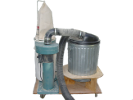
Jet Dust Collector plus a Separator |
Personal Protective Equipment |
| When one is done discussing tools that turn, cut, eject, and make noise, one should consider safety equipment. Here are some of the things I have. They don’t add one iota to the productivity in a project—in fact, it could be argued they subtract from it due to the (small) amount of time it takes to don the various devices (not all of them are needed for every job). However, although I’m not a proponent of the “it only takes once” philosophy, there is an element of risk in using machines that turn, cut, eject, and make noise that needs to be mitigated, if not, at least, considered. Here is some of my collection. |
|
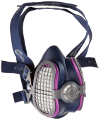
Elipse Dust Mask |
On most of the woodworking forums whenever someone asks about dust masks, the answer used to be the Dustfoe 88 (≈1997). Unfortunately, it was discontinued and mine has been consigned to theWoodbutcher’s Graveyard. Its replacement is the Elipse P100 by GVS. The model number appears to be SPR457. I got mine from Lee Valley, the legendary first class tool provider, but I see Amazon carries them, as well. |

David Clark Model 19A |
David Clark is famous for hearing protective headware. Both of mine (left and the one below) are actually black and came from an unnamed aircraft carrier on which an old friend served. I’ve had them for nearly 50 years and used them regularly just as long. The 19A is rated for 27 dB noise attenuation.
I’ve replaced the internal foam and the pads on the shells as they were quite worn. The units themselves look like new. The 10A is a shallower cup than the 19A and is rated for 23 dB noise attenuation, easily enough to quiet router whine, shop vac scream, small engine roar, saw/planer/jointer din, etc. Basically, if it makes noise, I get out my David Clarks. They’re also inexpensive enough to easily justify having one or two sets around…for when friends are over or SWMBO… |
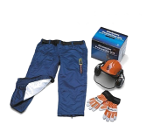
Husqvarna Safety Kit |
Husqvarna markets a chainsaw safety kit, which includes helmet, chaps, and gloves, as pictured here. I use them religiously. I supplemented the chaps with gaitors marketed for winter sports. It seems that whenever I was cutting while squatting (amazing how often that happens), the chips were flying under the chaps and into the tops of my boots. Most uncomfortable. |
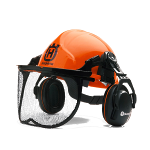
Husqvarna Helmet |
This helmet came with the saftey package from Husqvarna, but I wanted to picture it separately so you can more easily discern the features. It has a nice, adjustable headband, built in hearing protection (much like the David Clarks above), and incorporates a wire mesh face screen which can flip up out of the way. |
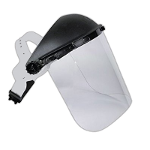
Face Shield |
The ubiquitous face shield. Sometimes one needs more protection than just for the eyes. Wood turning is an example, as can be grinding. Nothing like big chips or hot sparks to make you want something over your mouth and cheeks. So, just slip a good sized sheet of acrylic or polyarbonate in front of your face and go to town.
Seriously, though, you’ll want something a little more refined, such as an adjustable head band. This will get you there. Not expensive. Worth the price. Replacement lenses are often available, as grimy shops can be tough on plastic when cleaning the lens. I’ve had three or four of them over the years. I can’t remember when I got the first one. Figure in the ’70s. |
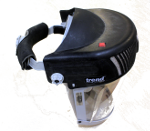
Trend Airshield |
Woodturning presents its own problems. One often spends a great deal of time turning, and on a hot day, it can get close behind that plastic. Sometimes it will even fog up on you. Enter Trend. They have a nice little battery powered fan in their product. It can be a welcome comfort during those long turning sessions. The red button is the switch for the fan. There is a cloth shroud inside which fits around the face, helping with dust and also containing the blast of air. I probably got this in the early aughts. |

Pyramex Wire Mesh Safety Glasses |
I’m a late convert to these, only learning of them from watching some logging videos on YouTube. Over the years I’ve used everything from dedicated polycarbonate lenses in glasses, to face shields (see above), to safety goggles. As my vision changes, various choices have had to be discarded as impractical.
Now, however, I can use these wire mesh goggles, which easily fit over both reading glasses (my usual shop wear) and my sunglasses (prescription, too, and for outside work like, er, logging). I lost my first pair as SWMBO commandeered them for her gardening, which task generates a surprising amount of detritus hard on the eyes. |
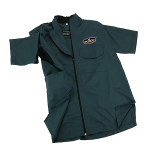
EasyWood Tools Turning Smock |
You’re excused if you’ve never heard of such a thing, but it doesn’t take much time at a lathe to find all the places a chip can find as you cut wood from the blank. A shirt on backwards would do the trick, closing the neck off in front, but they’re kind of hard to button that way. Enter the turning smock.
I’ve lusted after one for years, even suggesting SWMBO cobble one up for me, but at the same Woodcraft adventure in which the Nova Galaxi followed me home, this was on the closeout table at an honest price. The features are:
|
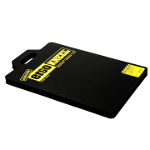
ErgoKneel |
Not a safety item, per se, but as the label “protective equipment” suggests, saving your knees (especially as one gets older) seems like a pretty good application of protection. I’ve used all kinds of knee pads over the years—tiling, flooring, paving, gardening—anywhere one spends time on their knees, even out in the shop. I won’t provide images as there are just so many varieties from which to choose. I will suggest a solid plastic insert, as it provides an added cushion. In recent years, I’ve often found myself using a leftover stadium pad from when the kids were in high school (a quarter of a century ago!), but I saw this ErgoKneel on a YouTube video and it intriqued me. I ordered one and was immediately transformed. Twice the size of the stadium pad, thicker, and much more comfortable, this is now my knee pad for life. |
Pneumatics |

Senco SFN40 Finish Nailer 
|
When you say professional tool, particularly in the pneumatic nailer department, the name Senco comes to mind. I had started in the air nailer field with a couple of Bostich T-31 brad nailer and stapler (because of Norm). When it came time to move up to a finish nailer, I got that Senco feeling. The SFN40 was the one I selected ≈1996), and all the reviews I’ve read put it at the top of the heap. I haven’t put all that many nails through it, but if you can grade a tool by feel and construction, this one is tops. |

Senco SN65 Framing Nailer |
Same idea as the Senco SFN40, when I decided (I still don’t know why) that I needed a framing nailer, that was the brand. I decided that full round head was the way to go, and reading about some of the building codes as they evolve, I think I did right. When I saw that the SN65 motor had about 15% more power than the SN60 for only a few dollars more, my fate was sealed (≈1997). I’ve used it a fair amount on the house remodel, and as a non-woodworking friend of mine said as I nailed a brace in his attic, “that’s a violent tool.” I took that as a compliment. |

Senco SLP20 Brad Nailer 
|
My T-31 nailer that got me started in pneumatics has passed to theWoodbutcher’s Graveyard. But when one door is closed another one opens elsewhere. I’ve long wanted an excuse for expanding the Senco suite, and the T-31’s demise was just the thing. I picked up the SLP20 at the borg (≈1998) and it is a sweet performer. |

Senco SFW08-C Stapler |
My T-31 stapler has also passed to the toolWoodbutcher’s Graveyard. And continuing the expanding-the-Senco-suite thinking, I picked up the SWF08-C online (≈2007). It’s a 3⁄8" crown upholstery stapler. I haven’t gotten any staples for it yet, but my daughter’s similar Porter-Cable works well, and since this is a Senco, I expect it to be just as sweet. I’m still looking for a narrow crown stapler—Senco, naturally. Stay tuned. Hah! It didn’t take long—see below. |

Senco SLS20 Stapler |
Apparently it takes two staplers to do the work of my late T-31 (RIP)—the SFW08 above and this baby I just picked up off ebay (8 second snipe—≈2008). In fairness, this will do more light construction type stapling than the T-31 was capable of, since it’s a ¼" crown. Construction as in cabinet carcases and the like, not framing or roofing. Well, I suppose you could use it for roofing, but staples in roofs isn’t universally accepted anyway. |

Remington 494 Stud Gun |
Some of the remodeling we’re doing calls for new walls, so a stud gun, which I’ve used before and always wanted one for my own, seemed like a reasonable idea (≈2003). I love it. Of course Tapcons would work, too, but there’s no satisfying firearm noise, no powder smell, and definitely no kick… |

Campbell-Hausfeld Compressor |
Since most of the tools in this section are air, naturally one needs a compressor. This is the second compressor I’ve had, but it’s really more like the first since the original (probably ≈1988—see theWoodbutcher’s Graveyard) was so much smaller and short-lived than this one (≈1992). Although I bought the Sears below to replace this, I decided to hang onto it, and I’m glad I did. It’s handy because it runs on 120V so can be used almost anywhere. It has handled the bulk of the air supply needs for the house remodel while the Sears sat in storage. |

Craftsman Compressor |
This is the one that’s the subject of one of my family stories in another part of this site. I’ve just recently (2006—purchased ≈1994) gotten it out of storage. Once I get the gar^H^H^Hshop wired and sided I’ll get this back in line and run some pipe (no, not PVC!). Actually, I’ve done all that. Check outthe Shop articleelsewhere on the site. I’ve recently learned that this machine was made for Sears by DeVilbiss, a respected manufacturer of pneumatics. Exagerrated horsepower aside, I’m somewhat comforted by that. |

Earlex HVLP Sprayer |
Can’t talk about air without talking about spraying, right? And while I have a regular cup sprayer, it’s so cheap and so generic, I won’t bother to document it. HVLP, however, is another story and here it is—I stopped by the local paint store, swapped some stories, bought some paint, asked some spraying questions. The tech guy mentioned he had an HVLP sprayer he was selling, brand new, with the box. He bought it to sell just when the economy tanked. He’d sell it to me for cost. Paid $213 for it (2011). He had $375 marked on the box, although I know they can be had a little cheaper. I’m in the HVLP biz! |
Hand Tools |

Klein Screwdrivers |
Klein screwdrivers aren’t exactly what you’d expect to see in a tool tour, but I bought a couple (≈1997—and for the next few years) when I was re-outfitting my electrical tool belt and I was amazed at the difference from the Craftsman I have everywhere. Can you imagine a Phillips head screwdriver that fits right and whose tip doesn’t distort at the drop of a hard turning screw? In Canada you can get them in Robertson (square drive) tips at Home Depot! Both the flat tip and Phillip’s head I got for my electrical belt have a short stud extending out of the handle parallel to the shank (you can just make it out in the full size picture) that can be used for turning a loop on a piece of wire. Nice touch. |
|
Klein 10-in-1 Screwdriver |
I’ve avoided tools like this for years as they were invariably cheaply made. Then I took home the Klein (≈2002). It provides: 5⁄16" & ¼" nut drivers, reversible screwdriver bits include: #2 Phillips-¼" slotted, #1 Phillips-3⁄16" slotted, #15-#10 Torx® and #1-#2 square-recess. I’m ready to take all the individual drivers out of my electrical tool kit. It’s amazing. |

Tohnichi Torque Screwdriver |
I didn’t even know torque screwdrivers existed until recently. Among other uses, they’re handy for ensuring the proper torque on the screws on circuit breakers. Since I’m installing a new breaker panel, this will be very handy for ensuring I got it right. I got this on ebay for $31 (≈2003). |

Sturtevant-Richmont Torque Screwdriver |
After getting the Tohnichi I realized it didn’t cover as large a range as I needed so I looked on ebay again and got this really nice Sturtevant-Richmont in a kit for about $40 (MSRP is around $200). A couple of days later someone who obviously didn’t know their tools had a Klein (made by S-R, and identical in appearance) with a Buy-it-Now price of $10 (≈2003). I could hardly get to my keyboard fast enough. Now I’m all cluttered up with torque screwdrivers. |

Stanley Bench Plane |
It’s hard to imagine a shop without planes (my first, probably in ’72—the Stanleys came in the aughts). I started out with a couple of Sears’, but replaced them recently with Stanleys. There is a difference. My daughter won’t care—she got the Sears’. |

Stanley Block Plane |
I did some serious Scary Sharp (TM) on the blade of this and it is amazing. I knocked down some framing that was a little twisted and out of, ahem, plane, with this in just seconds, and the pile of shavings was unbelievable—thin, consistent, and without much effort. |
|
Stanley #80 Scraper Plane |
Watching my friend, David Marks (yes, I’ve met him) use his Stanley #80 convinced me I needed one, so I found a good price and ordered it up (delivered the same day as the Senco stapler—Yeeha!). I haven’t used it yet, but I’m sure it will see some service. |

Leatherman Pocket Tool |
The Leatherman is my one and only geek tool. Well, maybe not, but I do get the most use out of this one (≈2005). It’s not really a shop tool, but since there was a picture available, I figured why not? It’s really only an emergency type tool; you wouldn’t want to put together an entertainment center with it; but when you need a screwdriver, Phillips head screwdriver, can opener, file, etc., and there’s absolutely nothing else around, you’ll want to kiss it. And it’s guaranteed for 25 years. |
Jigs (or is it fixtures?) |

Kreg Pocket Hole Jig |
I hadn’t even thought of getting one of these pocket hole jigs, because I figured with biscuits and other joinery I’d have no use for one. However I was in a store that had a sale…you know how that goes (1999). Anyway, what a neat tool. It’s one of those very rare acquisitions that’s even more than what you thought it might be. |

Rousseau Router Insert 
|
I was wandering around one time at the same store where I bought my biscuit joiner and inquired of one of the salesman about a router insert. He took me over to the accessories department and handed me a Rousseau RM3509 (≈1996). It’s perfect. It has two rings that can pop out to accomodate different size bits, and fits the standard Porter-Cable template guides in the smallest ring. It is easily fitted to any router with concentric rings embossed on the back. I bought a second one when I got my Hitachi. Then I got a third one when I got my second Hitachi. I’ve since (2014) bought a fourth (unfortunate shop accident—gravity, not surgery). Yep, Norm used one on his first router table. |

Delta Tenoning Jig 
|
After watching Norm (again) effortlessly cut tenons with his Delta jig, I decided I needed one to use on my ancient Craftsman table saw. I mean if you can’t have the best tools, you can at least have the best accessories. The first time I used it I was stunned (≈1995). This is a real tool. I know I’ve said that before, but when you start graduating to real tools, you can tell the difference. I had to do a couple of modifications to make it work on the Craftsman, but it was worth it. Now that I have the Unisaw, I have to un-modify it. |
Gas Tools |

Husqvarna Leaf Blower |
Okay, I threatened it—I’ve started another section. Not much in the way of woodworking, but this page is as much about tools as it is woodworking tools, anyway. And look at all the non-woodworking tools already. So, let us begin. I have such a problem with leaves and other tree detritus that I had to buy a leaf blower (≈2003—although I’ve been philosophically opposed to them for years). This back pack Husky is really slick. Pretty quiet, too. (That’s not me in the big picture.) |

Husqvarna 340 Chain Saw 
|
This has a little more to do with woodworking. Thanks to Hurricane Charley (2004) I had a pretty significant need for some serious wood cutting to get things off my roof. I bought this baby and put it to work. It did a great job. I’ve always wanted one anyway, and true to my philosophy; new job—new tool; I now have one, which will be used in the future to cut up green wood for turning bowls. |
|
Stihl FS45 String Trimmer |
SWMBO has been wanting to reclaim some of the natural part of the lawn from the primeval forest beyond the fence, and she’d rather take her time and do exactly what she wants than entrust it to the lawn guy (she refers to him as eye candy). So, I went over to the local dealer and found this string trimmer at just the right price (≈2006). I hope it makes up for that anniversary I missed… |
 Troy-Bilt Pressure Washer
Troy-Bilt Pressure Washer |
I was walking into the big box one day (≈2011) and they had a couple of these out front. Refurbs, and/or free rental army, but significantly discounted. I picked the one that had everything but the tips and the manual (and $80 more) and picked up a pack of tips inside. It was all I could do to hold SWMBO back. No, seriously, she had no problem with this purchase whatsoever, now that we have a place to store it. |
Unclassifiable |
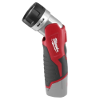
Milwaukee LED Flashlight |
I probably can’t adequately explain this acquisition. It relates to a tale I read in the comments section of some internet post (don’t ever read the comments) that claimed some, what I would characterize as, snake oil property of this particular tool. It related to the M12 Li Ion battery series. I wasn’t really buying it, but with three other M12 tools in inventory, as well as a slew of batteries, the potential of being useful was very, ahem, bright. And so it is. I’m glad I got it (the barebones version, by the way—who needs another battery?). Flash: SWMBO used mine a couple of times and fell in love with it, so I bought another body and now we have two. Here’s a story that may warm your heart. When I bought my original M12 driver, it came in a canvas tool bag. My next two M12s came in hard plastic cases, which I much prefer. I scoured the internet and found a plastic case for the original driver, and tossed the canvas bag over by the wall. When the second flashlight arrived, I decided to put the bag back into play as a two flashlight travel bag with room for a charger and spare battery. Result! Another Flash: Two, actually. A few months ago (April 2018) I picked up this cute little pocket LED light. Well, pocket, in the sense it will fit in a pocket, but not to conveniently carry like a pen or stylus. Still, it’s very handy—quite bright, has a magnetic base, easy to carry, but not like a pen. It has not gone unused. Then, today (21 August 2018) I was pawing through the Milwaukee display at Home Depot and found this man sized, Stick Light. It’s like the Sears light on steroids. And it’s part of the M12 series of which I have several tools, several batteries, and several chargers, in addition to the two flashlights that started off this section. Included is an adjustable hook for overhead work, and because of the battery, both balances nicely in a vertical position but has the heft of the battery to keep it in place. Also quite bright. |

Berger LM30 Rotary Laser |
I’ve seen rotary lasers used several times, both live and on TV home improvement shows, and with a house remodel coming up, I figured I’d invoke my rule; new job, new tool (≈2003). These are actually pretty affordable; around $200 at Lowes…cheaper on the ’net. |

Laser Pole |
Can’t have a rotary laser without a good mounting system (although I do have a good tripod, too) and this laser pole is pretty slick (2003). |

Tripod |
As advertised, I do have a tripod. It’s by Northwest, but it looks identical to the CST/Berger, and it does double duty with both the laser level and with a transit I also own. |
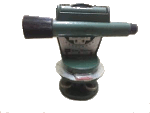
Keuffel & Esser 77-0330 Site Marker |
Said transit, actually labelled a “Site Marker” is a Keuffel & Esser 77-0330 borrowed and then bought from a coworker (probably ≈1992). It’s been difficult to find an image of it, but after years of trying, I finally scored a small one which needed a background edited out of it. For reference purposes, this is good enough. It’s surprising how many uses I’ve gotten from it. |

Greenlee 711K Toner Kit |
I told you there were other geek tools. This is a toner kit; one unit is a tone generator and the other is a detector. It’s used for identifying a particular wire in a bundle. Boy, has it been a big help in the remodel (2003). I’ve pulled several electrical cables plus Cat-5 phone lines and TV coax without a worry about having to mark them before the pull. It’s helped me trace a couple of existing runs of electrical that I couldn’t physically follow. |

Harris TS30 Butt Set |
And yet another. I’ve wanted a butt set for a long time for the odd phone work I do. The borg carries these and they radically dropped the price a while back (≈2005) and I snapped one up. It’s pretty handy for phone line testing when you’re not conveniently near a regular set. |
|
Voltage Detector |
The hits just keep on coming. If you do electrical work around the house or shop, you must have one of these—a non contact voltage detector. Even if you’ve turned off the circuit breaker you thought was for the circuit you’re going to work on, you should never trust that someone didn’t muck up the wiring somewhere along the line. For less than $20 it’s cheap insurance. I’ve had three, starting probably in the ’90s. |

Fluke 89-IV DMM |
Finally, one more. This is an incredible story. I’ve been using a Sears digital multimeter for some time. It’s okay, but I’ve always dreamed of a Fluke meter. They are the Cadillac of the industry (if it’s a good meter, it’s a Fluke). One of my internet friends out of the blue offered to try to get me one from a source in the industry. About a year later it showed up (≈2004). Brand new (discontinued). I was blown away. The reason? He said I’d been helpful to him over the years. We’ve never met. The ultimate gloat. Even better than the Workmate. |

Craftsman Tool Chest |
Although not technically a tool, tool chests like these are frequently on sale for reasonable prices at Sears and other stores and are extremely efficient in terms of storing myriad hand tools, measuring devices, files, accessories, etc. Theoretically they would reduce clutter such as can be seen both on the mid shelf and the top tray—that’s my fault, not theirs. I have two sets (they’re slightly different)—one for the shop and one for the garage (first one in the ’80s—of course, those are now the same space), plus a chest alone for drill press accessories. It’s still probably not enough. |
Last updated: 21 July 2018